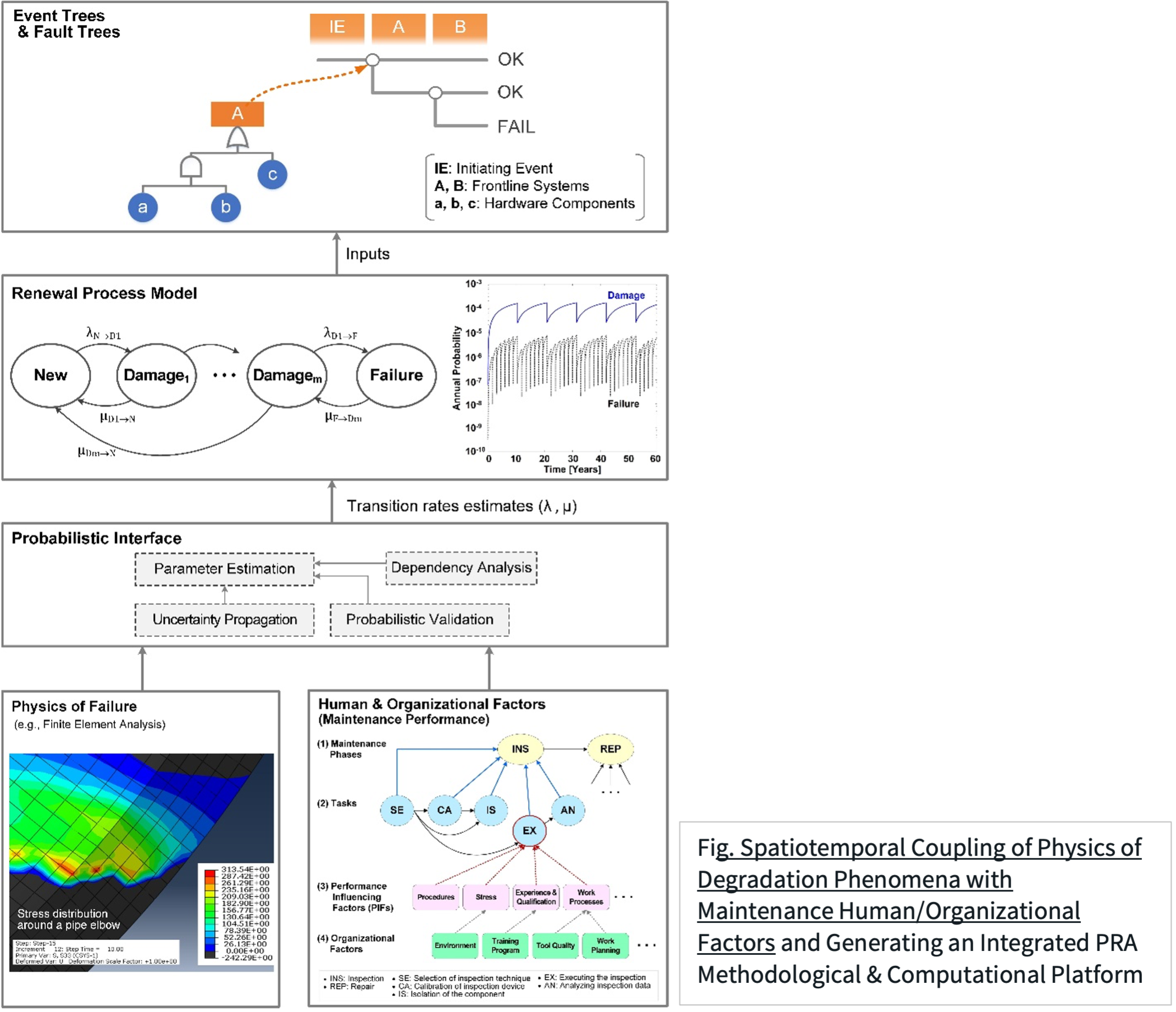For the successful deployment of a new fleet of advanced nuclear reactors, Probabilistic Risk/Safety Assessment (PRA/PSA) is one of the primary inputs to the risk-informed decision-making by the regulatory agency and the nuclear industry in various stages (design, licensing, construction, operation, and maintenance). The risk-informed analysis for advanced reactors is, however, challenging since (i) design-specific operating experience is quite limited or even unavailable; and (ii) for the systems and phenomena that do not exist in the operating nuclear power reactors, no consensus model that has been validated or peer-reviewed and widely adopted by the community is available.
To address these challenges, the SoTeRiA Laboratory has initiated a line of research to enhance PRA theories and methodologies for the risk-informed analysis of advanced nuclear reactors. This research is conducted in collaboration with the International Atomic Energy Agency (IAEA) under the Coordinated Research Project (CRP) award I31030, “Methodology for Assessing Pipe Failure Rates in Advanced Water Cooled Reactors.” This research has also been partially supported by the U.S. Department of Energy, Office of Nuclear Energy University Program (NEUP), Reactor Concepts Research Development and Demonstration (RCRD&D) under Award #17-12614.
An Integrated Probabilistic Physics-of-Failure (I-PPoF) Methodology
For risk-informed analysis of advanced nuclear power reactors, an Integrated Probabilistic Physics-of-Failure (I-PPoF) Methodology has been developed [Ref. 1, 2]. In I-PPoF, explicit models of physical degradation mechanisms and maintenance performance are coupled through a renewal process model to simulate the physics-maintenance interactions over time and space. I-PPoF helps address the first challenge stated above (i.e., the lack of operational experience) by quantifying the PRA model based on modeling of the underlying phenomena associated with PRA inputs instead of using a solely data-driven approach (as commonly done in PRA for operating nuclear power reactors).
Under the IAEA CRP project (award I31030), SoTeRiA’s I-PPoF methodology was applied to an AP1000 advanced water-cooled reactor to estimate pipe failure rate in a dissimilar metal weld in the cold leg subject to Primary Water Stress Corrosion Cracking (PWSCC). This application modeled the physical degradation due to PWSCC using the probabilistic physics-of-failure method. The explicit maintenance performance model analyzed the effects of the in-service inspection, flaw and leak detection, and repair/replacement and estimated the likelihood of human error for various maintenance tasks considering human and organizational factors. Probabilistic failure metrics were estimated using a state-based renewal process model to estimate the time-dependent cumulative and annual probabilities of pipe leak and rupture.
The details on the I-PPoF methodology and the application results have been published as part of IAEA-TECDOC-1988 [Ref. 3]
An Algorithm for Risk-Informed Analysis of Advanced Nuclear Power Reactors
To operationalize the I-PPoF methodology for advanced nuclear power reactors, the SoTeRiA Laboratory has developed an algorithm equipped with Probabilistic Validation (PV). This algorithm helps address the second challenge associated with the risk-informed analysis of advanced nuclear power reactors staged above (i.e., validation). This algorithm helps evaluate whether and how the structure and quantification of existing models, such as consensus models from conventional reactors and up-to-date models in academic literature, need to be updated for advanced reactors. The algorithm uses epistemic uncertainty as a measure of credibility, while sensitivity analyses are included to identify the most influential contributors to the output uncertainty, helping gradual and efficient improvements of realism and relevancy of the models that are needed for the I-PPoF methodological framework.
Although the proposed algorithm is applicable for risk-informed analysis of diverse advanced reactors, our publication [Ref. 3] demonstrated its applicability to a case study of pipe failure rate estimation for the dissimilar metal weld in the cold leg of AP-1000. The proposed algorithm identified the critical aspects of the maintenance performance model that required updating, including a qualitative screening process (based on a review of the existing regulatory standards and literature) and quantitative screening using Morris Elementary Effects (EE) analysis. The Morris EE analysis utilized the leak frequency metric at 60 years of plant operation to rank parameters based on their contribution to the uncertainty of the model output. This two-step screening process narrowed the focus of potential future research and demonstrated the practical value by helping decision-makers identify which parameters of the existing model are the most significant contributors to uncertainty in the model.
Ongoing research by the SoTeRiA Research Laboratory is implementing the remaining steps of the algorithm by conducting global sensitivity analysis and then reducing the overall model uncertainty by either generating more explicit models within the current I-PPoF approach or conducting experiments to collect additional data for calibration of the model(s).
References
- T. Sakurahara, N. O’Shea, W.-C. Cheng, S. Zhang, S. Reihani, E. Kee, Z. Mohaghegh, Integrating renewal process modeling with probabilistic physics-of-failure: Application for estimation of loss of coolant accident (LOCA) frequencies in nuclear power plants, Reliability Engineering and System Safety, Vol. 190, 106479, (2019).
- W.-C. Cheng, J. Beal, T. Sakurahara, S. Reihani, E. Kee, Z. Mohaghegh, Integrated Probabilistic Physics of Failure Methodology to Estimate Pipe Failure Rates for Risk-Informed Analysis of Advanced Nuclear Reactors, Proceedings of 2020 American Nuclear Society (ANS) Winter Meeting, Online Virtual Conference, (2020).
- International Atomic Energy Agency, Technical Insights from Benchmarking Different Methods for Predicting Pipe Failure Rates in Water Cooled Reactors, IAEA-TECDOC No. 1988, 2021.
- J. Beal, T. Sakurahara, S. Reihani, E. Kee, Z. Mohaghegh, An Algorithm for Risk-Informed Analysis of Advanced Reactors with a Case Study of Pipe Failure Rate Estimation, Proceedings of 30th European Safety and Reliability Conference & 15th Probabilistic Safety Assessment and Management Conference (ESREL2020 & PSAM15), Venice, Italy, (2020).
